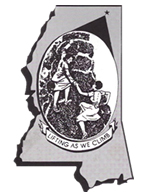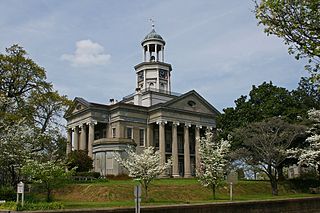
The National Association of Colored Women's Clubs (NACWC) is an American organization that was formed in July 1896 at the First Annual Convention of the National Federation of Afro-American Women in Washington, D.C., United States, by a merger of the National Federation of African-American Women, the Woman's Era Club of Boston, and the National League of Colored Women of Washington, DC, at the call of Josephine St. Pierre Ruffin. From 1896 to 1904 it was known as the National Association of Colored Women (NACW). It adopted the motto "Lifting as we climb", to demonstrate to "an ignorant and suspicious world that our aims and interests are identical with those of all good aspiring women." When incorporated in 1904, NACW became known as the National Association of Colored Women's Clubs (NACWC).
The Mississippi Democratic Party is the affiliate of the Democratic Party in the state of Mississippi. The party headquarters is located in the state capital, Jackson, Mississippi.

Helen Elsie Austin was an American attorney, member of the Bahá'í National Spiritual Assemblies in the United States and for the then regional assembly of North West Africa, and worked for years as an US Foreign Service Officer in Africa. She was among the first African American's admitted to the practice of law in the United States, was assistant attorney general in Ohio, served on numerous committees, executive positions, and consulted, for the Bahá'ís, the National Association for the Advancement of Colored People, the National Council of Negro Women, and was a president for the Delta Sigma Theta sorority.
Daisy Elizabeth Adams Lampkin was an American suffragist, civil rights activist, organization executive, and community practitioner whose career spanned over half a century. Lampkin’s effective skills as an orator, fundraiser, organizer, and political activist guided the work being conducted by the National Association of Colored Women (NACW); National Association for the Advancement of Colored People (NAACP); National Council of Negro Women and other leading civil rights organizations of the Progressive Era.
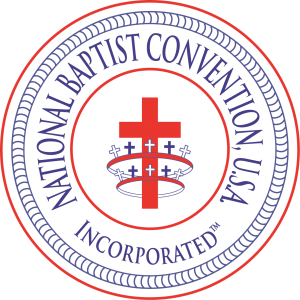
The National Baptist Convention, USA, Inc., more commonly known as the National Baptist Convention, is the largest predominantly African-American Christian denomination in the United States. It is headquartered at the Baptist World Center in Nashville, Tennessee and affiliated with the Baptist World Alliance. The denomination claims approximately 31,000 congregations and reports having an estimated 7.5 million members.
The following is a timeline of the history of the city of Jackson, Mississippi, USA.
Washington Conservatory of Music and School of Expression was a private music academy founded by Harriet Gibbs Marshall in 1903 in Washington, D.C. to train African Americans in music. The Conservatory remained open until 1960 making it the longest operating music school for African Americans.
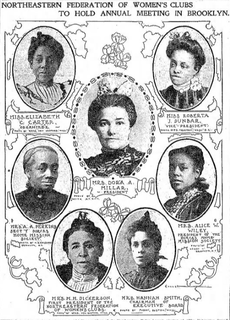
The Northeastern Federation of Colored Women's Clubs (NFCWC) is an umbrella organization representing black women's clubs in the northeastern United States. The organization was affiliated with the National Association of Colored Women's Clubs (NACWC). It was the first umbrella organization for black women's clubs in the United States, predating the NACWC by a month. The motto of the club is "For God and Humanity."
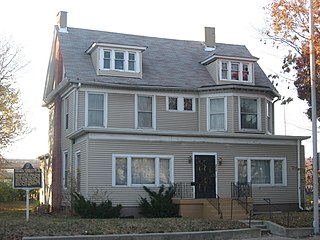
Indiana State Federation of Colored Women's Clubs, also known as the Minor House, is a historic National Association of Colored Women's Clubs clubhouse in Indianapolis, Indiana. The two-and-one-half-story "T"-plan building was originally constructed in 1897 as a private dwelling for John and Sarah Minor; however, since 1927 it has served as the headquarters of the Indiana State Federation of Colored Women's Clubs, a nonprofit group of African American women. The Indiana federation was formally organized on April 27, 1904, in Indianapolis and incorporated in 1927. The group's Colonial Revival style frame building sits on a brick foundation and has a gable roof with hipped dormers. It was listed on the National Register of Historic Places in 1987.

The woman's club movement was a social movement that took place throughout the United States. While women's organizations had always been a part of United States history, it was not until the Progressive era that it came to be considered a "movement." The first wave of the club movement during the Progressive era was started by white, middle-class, Protestant women and a second phase by African-American women.
The Texas Association of Women's Clubs (TAWC) is an umbrella organization of African American women's clubs in Texas. It was first organized as the Texas Federation of Colored Women's Clubs in 1905. The purpose of the group was to allow clubs to work together to improve the social and moral life of people in Texas. The club also spoke on topics of interest to black women in the United States.
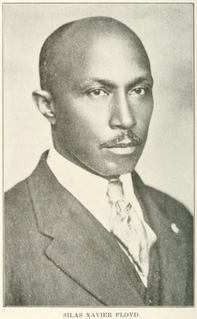
Silas Xavier Floyd (1869–1923) was an educator, preacher, and journalist. An African-American, he was a writer and editor at the Augusta Sentinel and later a writer at the Augusta Chronicle in Augusta, Georgia. In 1892 he was a co-founder of the Negro Press Association of Georgia. He was pastor at Augusta's Tabernacle Baptist Church and was a prominent agent of the International Sunday School Convention. He was also a public school principal and an officer of the National Association of Teachers in Colored Schools.

Hester C. Jeffrey, nee Whitehurst was an African American activist, suffragist, and community organizer in New York City. She is known for her involvement with the Political Equality Club, the Women's Christian Temperance Union, and the National Association of Colored Women's Clubs.

The South Carolina Federation of Colored Women's Clubs (SCFCWC) was an African American women's club founded in 1909 in South Carolina. The umbrella organization was created by Marion Bernie Wilkinson, Sara B. Henderson, Lizella A. Jenkins Moorer, Celia Dial Saxon and other women who met at Sydney Park Church in Columbia. They adopted the motto of the National Association of Colored Women's Clubs (NACWC), "Lifting as We Climb." Wilkinson became the first president and worked towards improving education and living conditions for black people in South Carolina. The organization grew to have twenty-five hundred members in 1922. One of the major accomplishments of the SCFCWC was the creation of the Wilkinson Home for Colored Girls in Cayce. The home was originally for girls who had been deemed "delinquent" and later housed orphans.
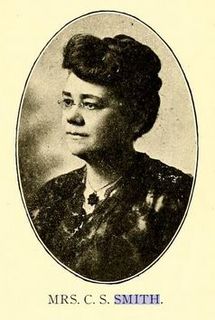
Christine Shoecraft Smith was an African-American community worker began her career as the assistant principal of the Alabama State Normal and Industrial School. She married an AME minister, who would become a bishop in the church and assisted him as the manager of the press organ of the Sunday School Union. She worked in many clubs and served as the 13th president of the National Association of Colored Women's Clubs (NACWC).
The Woman's Era Club was an African-American women's civic organization founded in Boston, Massachusetts, in between 1892 and 1894 by Josephine St. Pierre Ruffin. The Club was the first black women's club in Boston. The organization was especially well-known for the conflict caused when Ruffin attempted to desegregate the General Federation of Women's Clubs (GFWC) in 1900.
The Empire State Federation of Women's Clubs (ESFWC) was founded in 1908 and is an umbrella organization for African-American women's groups in New York. The organization worked to help improve the lives of young women and helped care for Harriet Tubman until her death in 1913. The organization was affiliated with the National Association of Colored Women's Clubs, and worked with the NAACP.
The Iowa Federation of Colored Women's Clubs (IFCWC) was an umbrella organization serving African-American women's clubs in Iowa. The motto of IFCWC was "Sowing Seeds of Kindness," and the organization was affiliated with the National Association of Colored Women. The club produced a journal called the Iowa Colored Woman. IFCWC sent delegates to represent the state at national conventions and opportunities such as "Colored Women's day" at the 1939 New York World's Fair. The IFCWC is also known for creating a black women's dormitory for the University of Iowa before the school was fully integrated.
John F. Harris was an American lawyer and politician from Greenville, Mississippi. In the mid- and late-1880s he was a member of the Greenville city council and in 1890 he was elected to the Mississippi House of Representatives. He was also a member of numerous local civic organizations. He is noted for an 1890 speech given to the state house in support of an appropriations bill for a monument to Confederate veterans of the American Civil War.

The Mississippi Federation of Women's Clubs Headquarters houses the Mississippi Federation of Women's Clubs. It was constructed in 1936 by the Works Progress Administration (WPA).
